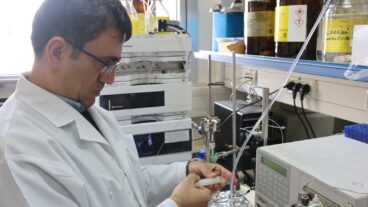The Technion-developed device that aids walking displays a ‘virtual floor’ that adjusts as the user moves.A professor at the Technion-Israel Institute of Technology has found a new way to help sufferers of Parkinson’s and other debilitating diseases by using a technology originally developed for helicopter pilots.
The invention uses virtual reality to help those who have trouble walking to better control their gait. In addition to Parkinson’s patients, it helps those whose mobility has been impaired due to a stroke as well as people who suffer from senile gait, one of the primary causes of falls by the elderly and subsequent hospital admissions.
Prof. Yoram Baram, who holds a PhD in electrical engineering and computer science from MIT, once designed a mechanism for the U.S. National Aeronautics and Space Administration that helped helicopters navigate at low altitudes around obstacles such as electrical poles and trees. Several years after his work for NASA he was watching television and heard a man with Parkinson’s describe how he found it easier to walk on a tiled floor since the grid pattern made the image more stable.
Baram made a connection between his work for NASA and the Parkinson’s patient’s description. The design Baram later used for the new medical device is based on the idea that optical images of fixed objects help people stabilize themselves, whether they are walking or flying a helicopter.
“A person who is walking uses visual images to navigate so he doesn’t collide with other objects,” Baram said. The device helps the patients remain stable while walking without the use of drugs to mitigate the affects of the disease.
“It is noninvasive, non-pharmacological and has no side effects,” Baram said.
The patented device is comprised of a wearable computer and glasses that display a “virtual floor.” As the user walks, the virtual floor adjusts according to the user’s movements.
“When the patient stands in place, the virtual floor doesn’t move,” Baram said. “But when he begins to walk, the floor begins moving beneath him. When he turns, the image of the floor also turns. All the while the patient feels like he is walking on a steady floor.”
The idea of wearing a simple device in place of surgery or taking medications could prove appealing. Baram said he thinks the worldwide market for the new device could be as high as 100 million users.
Clinical trials have shown that people who need assistance with walking experience clear improvement after using the device for as little as 30 minutes. In trials, there are also indications that the device may help people navigate better after they have quit using it, although this effect needs to be studied in more depth.
The device has shown to be useful in patients who suffer from Stage Four Parkinson’s (Stage Five is considered the most severe form of the disease). Besides improving motor coordination, some patients who have difficulty speaking showed improvement in their ability to talk while wearing the device.
The device may prove useful for Cerebral Palsy patients and there are even some suggestions that it could help those who suffer from dyslexia – although these areas have not yet been studied, Baram said.
According to Baram, the device helped patients speed up their gait by an average of 26 percent and lengthen their stride by 31 percent. Some patients who use the device may even realize an improvement in walking of as high as 50 to 100 percent.
Baram worked with Dr. Judith Aharon Peretz, head of the Department of Cognitive Neurology at Rambam Hospital in Haifa, Israel, where the device was tested on about 40 patients. They studied only Parkinson’s patients at first, but later included stroke victims. They are now testing the device in a number of old-age homes in Haifa and will soon be expanding tests in other areas of Israel.
During the next six months, Baram and his team will focus on completing of the next phase of clinical trials and work on miniaturizing the device, which weighs 800 grams. Baram hopes to be able to get the Walkman-sized device down to a 50 grams and expects it to cost between $200 and $400.
The team is trying to raise $1 million to $2 million in venture funding to support its efforts to develop and sell the device.












